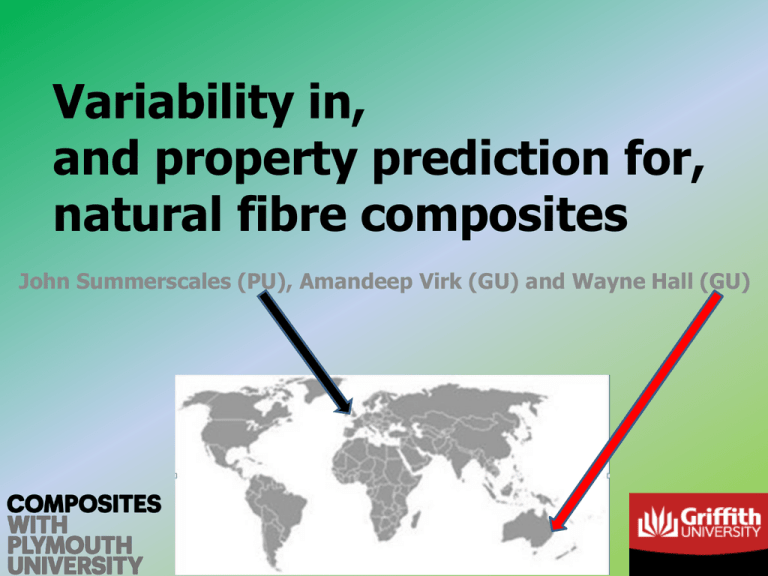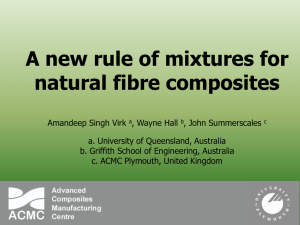PowerPoint
advertisement

Variability in, and property prediction for, natural fibre composites John Summerscales (PU), Amandeep Virk (GU) and Wayne Hall (GU) Acknowledgements • The authors would like to thank a former colleague, Joe Ellison, for obtaining the fibres from IJIRA/IJSG. • ASV is grateful to the University of Plymouth for a scholarship to pursue his doctorate. • Technical assistance was provided by Richard Cullen, Greg Nash and Terry Richards. Natural fibres • tensile properties of retted technical jute fibres from a 127 mm wide roll with an areal weight of 880 g/m2 from a single source in South Asia previously characterised • 785 individual fibres tested: – 100 fibres at each of 6, 10, 20, 30 and 50 mm GL – 50 fibres at each of 100, 150, 200, 250 and 300 mm GL • fibre length distribution from ISO 6989 – ‘Method A’ • apparent cross-sectional area of each fibre from the mean fibre ‘diameter’ assuming a circular cross-section Mechanical testing of fibre • Fibres tested in tension using an Instron 3345 K1669 universal testing machine with an Instron 500 N load cell • Grafil method 101.13, modified for different fibre lengths (broadly similar to ASTM D3379-75) • constant strain rate of 0.01 min-1 for all gauge lengths Effect of fibre length Plots of … • strength (MPa) • strain (%) • coefficients of variation (CoV) – normalised measure of dispersion of a probability distribution – CoV = standard deviation/mean value Fibre strength against mean fibre length As gauge length increases, fibre strength decreases Fibre fracture strain against fibre length Fracture strain is strongly influenced by the fibre length Linear trend line through CoV for strength and fracture strain CoV of fracture strain consistently lower than CoV of strength at each of the measured fibre lengths Effect of fibre diameter Plots of … • strength (MPa) • strain (%) • coefficients of variation (CoV) – normalised measure of dispersion of a probability distribution – CoV = standard deviation/mean value As fibre diameter increases, fibre strength decreases Fibre fracture strain against mean fibre diameter 36% reduction in fracture strain as the mean fibre diameter increases: small when compared to the 83% reduction in the fibre strength Grouping fibre diameter data • fibre gauge length can be selected for size • fibre diameter is an independent variable which cannot be selected • to determine the effect of the fibre diameter on strength and fracture strain the fibre diameter is grouped in classes (bins) • bin width of 10 μm is chosen for the fibre diameter • resulting groups used in the following Figures Fibre strength against fibre diameter group Fracture strain against fibre diameter group. AS Virk, W Hall and J Summerscales, Strain as the key design criterion for failure of natural fibre composites, Composites Science and Technology, June 2010, 70(6), 995-999. Strength and fracture strain CoV against fibre diameter Variability - conclusions • NF have perceived high variability in strength. • coefficient of variation (CoV) for failure strain is consistently lower than CoV for fracture stress (strength) • failure strain is the more consistent failure criterion • optical microscopy to determine fibre ‘‘diameter” and hence cross-sectional area (CSA) explains this difference • strength is normally calculated from an assumed CSA • strain is independent of CSA Quasi-UD jute/epoxy composite Cross-section (top): used to determine fibre volume fraction Plan view (bottom): used to determine FODF for dyed/pigmented plate … but fibre CSA not round typical cross-sections of jute technical fibres Apparent and true fibre area distributions Geometric means of the log normal distributions calculated Apparent and true fibre CSAs to be 2697 and 1896 μm2 respectively. Apparent CSA is overestimate, so fibre modulus and strength underestimated Fibre area correction factor κ • • • • FACF compensates for overestimate in apparent CSA FACF calculated as the ratio of apparent CSA/true CSA For the jute fibre considered here, κ =1.42 (i.e. 2697/1896) Young’s modulus of jute fibres reduces with increasing fibre diameter J Summerscales, W Hall and AS Virk, A fibre diameter distribution factor (FDDF) for natural fibre composites, Journal of Materials Science, September 2011, 46(17), 5876-5880. Fibre diameter distribution factor: FDDF ηd Rules of mixtures • Ec = ηl ηo Vf Ef + Vm Em • σ'c = Vf σ'f + Vm σm* • Vf + Vm + Vv = 1 • Ec = κ ηd ηl ηo Vf Ef + Vm Em • σ'c = κ Vf σ'f + Vm σm* κ = fibre area correction factor ηd = fibre diameter distribution factor ηl = fibre length distribution factor θ = mean fibre angle ηo = fibre orientation distribution factor Vf = fibre volume fraction = = = = = = 1.42 1.00 1.00 7.4 ± 18° 0.81 ± 0.06 18.9 ± 3.9 % AS Virk, W Hall and J Summerscales, Modulus and strength prediction for natural fibre composites, Materials Science and Technology, July 2012, 28(7), 864-871. Modified rules of mixtures Comparison of predicted moduli from rule of mixtures without (left/blue) and with (right/red) the fibre area correction factor Results for quasi-UD composites • average tensile modulus (dyed): • average tensile modulus (un-dyed): • calculated modulus: • • • • 8.18 ± 0.6 GPa 8.47 ± 1.18 GPa 8.24 ± 0.57 GPa average tensile strength (dyed): 100.0 ± 5.7 MPa average tensile strength (un-dyed): 101.0 ± 17.2 MPa calculated strength (new RoM/MDS-WLS): 95.0 MPa calculated strength (new RoM/NLIM): 102.9 MPa MDS-WLS: multiple data set weak link scaling NLIM: natural logarithm interpolation method Conclusions – new RoM • using linear measurements of fibre diameter and assumed circular cross-section overestimates CSA • hence low values of key mechanical properties (i.e. modulus and strength) of natural fibres or composites • FACF and FDDF proposed for use in RoM to predict the tensile modulus and strength of NF composites • FACF shown to improve the prediction of tensile modulus and strength for the authors’ and other experiments reported in the literature. Thank you for your attention Any questions ?








